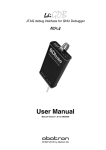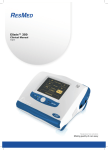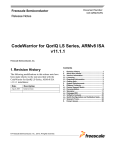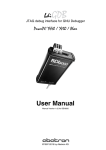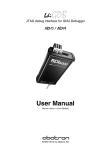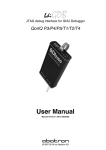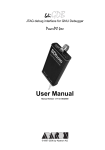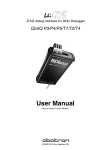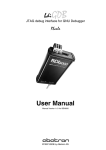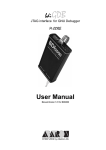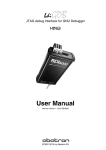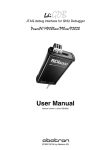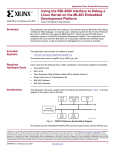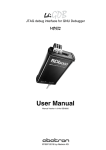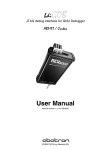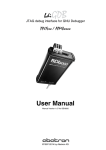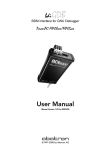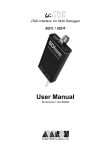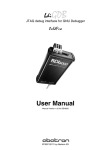Download bdiGDB User Manual
Transcript
bdi GDB
JTAG debug interface for GNU Debugger
ARMv8
User Manual
Manual Version 1.01 for BDI3000
©1997-2015 by Abatron AG
bdiGDB for GNU Debugger, BDI3000 (ARMv8)
User Manual
2
1 Introduction ................................................................................................................................. 4
1.1 BDI3000................................................................................................................................. 4
1.2 BDI Configuration .................................................................................................................. 5
2 Installation ................................................................................................................................... 6
2.1 Connecting the BDI3000 to Target ........................................................................................ 6
2.1.1 Serial Wire Debug ........................................................................................................ 9
2.2 Connecting the BDI3000 to Power Supply .......................................................................... 10
2.3 Status LED «MODE»........................................................................................................... 11
2.4 Connecting the BDI3000 to Host ......................................................................................... 12
2.4.1 Serial line communication .......................................................................................... 12
2.4.2 Ethernet communication ............................................................................................ 13
2.5 Installation of the Configuration Software ............................................................................ 14
2.5.1 Configuration with a Linux / Unix host........................................................................ 15
2.5.2 Configuration with a Windows host ............................................................................ 17
2.5.3 Configuration via Telnet / TFTP ................................................................................. 19
2.6 Testing the BDI3000 to host connection.............................................................................. 21
2.7 TFTP server for Windows .................................................................................................... 21
3 Using bdiGDB ............................................................................................................................ 22
3.1 Principle of operation ........................................................................................................... 22
3.2 Configuration File................................................................................................................. 23
3.2.1 Part [INIT]................................................................................................................... 24
3.2.2 Part [TARGET] ........................................................................................................... 26
3.2.3 Part [HOST]................................................................................................................ 32
3.2.4 Part [FLASH] .............................................................................................................. 34
3.2.5 Part [REGS] ............................................................................................................... 38
3.3 Debugging with GDB ........................................................................................................... 40
3.3.1 Target setup ............................................................................................................... 40
3.3.2 Connecting to the target............................................................................................. 40
3.3.3 Breakpoint Handling................................................................................................... 41
3.3.4 GDB monitor command.............................................................................................. 41
3.3.5 Target serial I/O via BDI............................................................................................. 42
3.3.6 Target DCC I/O via BDI.............................................................................................. 43
3.4 Telnet Interface.................................................................................................................... 44
3.4.1 Command list ............................................................................................................. 45
3.5 Multi-Core Support............................................................................................................... 48
4 Specifications ............................................................................................................................ 51
5 Environmental notice................................................................................................................ 52
6 Declaration of Conformity (CE)................................................................................................ 52
7 Warranty and Support Terms................................................................................................... 53
7.1 Hardware ............................................................................................................................. 53
7.2 Software .............................................................................................................................. 53
7.3 Warranty and Disclaimer ..................................................................................................... 53
7.4 Limitation of Liability ............................................................................................................ 53
© Copyright 1997-2015 by ABATRON AG Switzerland
V 1.01
bdiGDB for GNU Debugger, BDI3000 (ARMv8)
User Manual
3
7.4 Appendices
A Troubleshooting ....................................................................................................................... 54
B Maintenance .............................................................................................................................. 55
C Trademarks ............................................................................................................................... 55
© Copyright 1997-2015 by ABATRON AG Switzerland
V 1.01
bdiGDB for GNU Debugger, BDI3000 (ARMv8)
User Manual
4
1 Introduction
bdiGDB enhances the GNU debugger (GDB), with JTAG debugging for ARMv8 based targets. With
the built-in Ethernet interface you get a very fast download speed. No target communication channel
(e.g. serial line) is wasted for debugging purposes. Even better, you can use fast Ethernet debugging
with target systems without network capability. The host to BDI communication uses the standard
GDB remote protocol.
An additional Telnet interface is available for special debug tasks (e.g. force a hardware reset,
program flash memory).
The following figure shows how the BDI3000 interface is connected between the host and the target:
Target System
ARM
Unix / PC Host
BDI3000
GNU Debugger
(GDB)
Ethernet (10/100 BASE-T)
1.1 BDI3000
The BDI3000 is the main part of the bdiGDB system. This small box implements the interface between the JTAG pins of the target CPU and a 10/100Base-T Ethernet connector. The firmware of the
BDI3000 can be updated by the user with a simple Linux/Windows configuration program or interactively via Telnet/TFTP. The BDI3000 supports 1.2 – 5.0 Volts target systems.
© Copyright 1997-2015 by ABATRON AG Switzerland
V 1.01
bdiGDB for GNU Debugger, BDI3000 (ARMv8)
User Manual
5
1.2 BDI Configuration
As an initial setup, the IP address of the BDI3000, the IP address of the host with the configuration
file and the name of the configuration file is stored within the flash of the BDI3000.
Every time the BDI3000 is powered on, it reads the configuration file via TFTP.
Following an example of a typical configuration file:
; bdiGDB configuration for ARMv8 based X-Gene processor
; ----------------------------------------------------;
[INIT]
; empty init list
;
[TARGET]
POWERUP
3000
;start delay after power-up detected in ms
CLOCK
8000000
;JTAG clock 8 MHz
TRST
OPENDRAIN
;TRST driver type (OPENDRAIN | PUSHPULL)
;
; CoreID#0 parameters (active core after reset)
#0 CPUTYPE
X-GENE 0xfc010000
;X-Gene CPU 0
#0 STARTUP
HALT
;halt as soon as possible
#0 ENDIAN
LITTLE
;memory model (LITTLE | BIG)
#0 VECTOR
CATCH RST OSU TDA
;Reset and OS unlock catch, Trap SW access
#0 BREAKMODE
SOFT
;SOFT or HARD
#0 MEMACCESS
CORE
10
;memory access via Core (80 TCK's access delay)
;
; CoreID#1 parameters:
#1 CPUTYPE
X-GENE 0xfc110000
;X-Gene CPU 1
#1 STARTUP
RUN
#1 ENDIAN
LITTLE
#1 BREAKMODE
HARD
#1 MEMACCESS
CORE
10
;
; CoreID#2 parameters:
#2 CPUTYPE
X-GENE 0xfc210000
;X-Gene CPU 2
#2 STARTUP
RUN
#2 ENDIAN
LITTLE
#2 BREAKMODE
HARD
#2 MEMACCESS
CORE
10
;
; CoreID#3 parameters:
#3 CPUTYPE
X-GENE 0xfc310000
;X-Gene CPU 3
#3 STARTUP
RUN
#3 ENDIAN
LITTLE
#3 BREAKMODE
HARD
#3 MEMACCESS
CORE
10
;
;
[HOST]
#0 PROMPT
XGENE#0>
#1 PROMPT
XGENE#1>
#2 PROMPT
XGENE#2>
#3 PROMPT
XGENE#3>
[REGS]
FILE
$regARMV8-EL2.def
Based on the information in the configuration file, the target is automatically initialized after every reset.
© Copyright 1997-2015 by ABATRON AG Switzerland
V 1.01
bdiGDB for GNU Debugger, BDI3000 (ARMv8)
User Manual
6
2 Installation
2.1 Connecting the BDI3000 to Target
The enclosed cables to the target system are designed for the ARM Development Boards. In case
where the target system has the same connector layout, the cable can be directly connected (14-pin
EmbeddedICE or 20-pin Multi-ICE).
!
In order to ensure reliable operation of the BDI (EMC, runtimes, etc.) the target cable length must not
exceed 20 cm (8").
1
BDI
BDI3000
1 - Vcc Target
2 - NC
3 - TRST
20
2
1
13
4 - NC
14 pin EmbeddedICE 5 - TDI
Connector
6 - NC
1 - Vcc Target
7 - TMS
14
2
2 - GROUND
8 - GROUND
3 - TRST
9 - TCK
4 - GROUND
10 - GROUND
5 - TDI
11 - NC
6 - NC
12 - NC
7 - TMS
13 - TDO
BDI
TARGET A
TARGET B
8 - NC
14 - NC
9
1
9 - TCK
15 - RESET
10 - NC
16 - NC
11 - TDO
17 - NC
12 - RESET
2
18 - NC
10
13 - NC
19 - NC
20 - NC
The green LED «TRGT» marked light up when target is powered up 14 - NC
TRGT
ARM
20 pin Multi-ICE
Connector
MODE
Target System
19
For BDI MAIN / TARGET A connector signals see table on next page.
Warning:
Before you can use the BDI3000 with an other target processor type (e.g. PPC <--> ARM), a new
setup has to be done (see chapter 2.5). During this process the target cable must be disconnected
from the target system.
!
To avoid data line conflicts, the BDI3000 must be disconnected from the target system while
programming a new firmware for an other target CPU.
© Copyright 1997-2015 by ABATRON AG Switzerland
V 1.01
bdiGDB for GNU Debugger, BDI3000 (ARMv8)
User Manual
7
TARGET A Connector Signals
Pin
Name
Description
1
reserved
This pin is currently not used.
2
TRST
JTAG Test Reset
This open-drain / push-pull output of the BDI3000 resets the JTAG TAP controller on the
target. Default driver type is open-drain.
3+5
GND
System Ground
4
TCK
JTAG Test Clock
This output of the BDI3000 connects to the target TCK line.
6
TMS
JTAG Test Mode Select
This output of the BDI3000 connects to the target TMS line.
7
RESET
This open collector output of the BDI3000 is used to reset the target system.
8
TDI
JTAG Test Data In
This output of the BDI3000 connects to the target TDI line.
9
Vcc Target
1.2 – 5.0V:
This is the target reference voltage. It indicates that the target has power and it is also used
to create the logic-level reference for the input comparators. It also controls the output logic
levels to the target. It is normally fed from Vdd I/O on the target board.
10
TDO
JTAG Test Data Out
This input to the BDI3000 connects to the target TDO line.
For TARGET B connector signals see table on next page.
The BDI3000 works also with targets which have no dedicated TRST pin. For this kind of targets, the
BDI cannot force the target to debug mode immediately after reset. The target always begins execution of application code until the BDI has finished programming the Debug Control Register.
Note:
For targets with a 10-pin or 20-pin Cortex Debug Connector (Samtec 0.05" micro header) a special
adapter is available. This Cortex Adapter can be ordered separately from Abatron (p/n 90085).
Warning:
Before you can use the BDI3000 with an other target processor type (e.g. PPC <--> ARM), a new
setup has to be done (see chapter 2.5). During this process the target cable must be disconnected
from the target system.
!
To avoid data line conflicts, the BDI3000 must be disconnected from the target system while
programming a new firmware for an other target CPU.
© Copyright 1997-2015 by ABATRON AG Switzerland
V 1.01
bdiGDB for GNU Debugger, BDI3000 (ARMv8)
User Manual
8
BDI TARGET B Connector Signals:
Pin
Name
Description
1
TDO
JTAG Test Data Out
This input to the BDI3000 connects to the target TDO line.
2
reserved
3
TDI
4
reserved
5
RTCK
Returned JTAG Test Clock
This input to the BDI3000 connects to the target RTCK line.
6
Vcc Target
1.2 – 5.0V:
This is the target reference voltage. It indicates that the target has power and it is also used
to create the logic-level reference for the input comparators. It also controls the output logic
levels to the target. It is normally fed from Vdd I/O on the target board.
7
TCK
JTAG Test Clock
This output of the BDI3000 connects to the target TCK line.
8
TRST
JTAG Test Reset
This open-drain / push-pull output of the BDI3000 resets the JTAG TAP controller on the
target. Default driver type is open-drain.
9
TMS
JTAG Test Mode Select
This output of the BDI3000 connects to the target TMS line.
10
reserved
11
reserved
12
GROUND
System Ground
13
RESET
System Reset
This open-drain output of the BDI3000 is used to reset the target system.
14
reseved
15
reseved
16
GROUND
JTAG Test Data In
This output of the BDI3000 connects to the target TDI line.
System Ground
© Copyright 1997-2015 by ABATRON AG Switzerland
V 1.01
bdiGDB for GNU Debugger, BDI3000 (ARMv8)
User Manual
9
2.1.1 Serial Wire Debug
The BDI3000 supports also the „Serial Wire Debug Port“ (SW-DP). In order to use SW-DP a different
firmware has to be loaded into the BDI3000 (included on the CD). Also a special target cable is available on request (p/n 90054).
grey
grey
grey
Target System
grey
red
ARM
V
SWO/SWV
C
SWCLK
D
SWDIO
R
Reset
+
Vcc Target
black
Ground
TRGT
MODE
BDI
BDI3000
BDI
TARGET A
9
1
10
2
TARGET B
The green LED «TRGT» marked light up when target is powered up
TARGET A Connector Signals
Pin
Name
Describtion
3
GND
System Ground
4
SWCLK
Serial Wire Clock
6
SWDIO
Serial Wire Debug Data Input/Output
10
SWO/SWV
Serial Wire Output / Viewer (optional trace output)
7
RESET
This open collector output of the BDI2000 can be used to hard reset the target system.
9
Vcc Target
1.2 – 5.0V:
This is the target reference voltage. It indicates that the target has power and it is also used
to create the logic-level reference for the input comparators. It also controls the output logic
levels to the target. It is normally fed from Vdd I/O on the target board.
© Copyright 1997-2015 by ABATRON AG Switzerland
V 1.01
bdiGDB for GNU Debugger, BDI3000 (ARMv8)
User Manual
10
2.2 Connecting the BDI3000 to Power Supply
The BDI3000 needs to be supplied with the enclosed power supply from Abatron (5VDC).
!
Before use, check if the mains voltage is in accordance with the input voltage printed on power
supply. Make sure that, while operating, the power supply is not covered up and not situated near
a heater or in direct sun light. Dry location use only.
!
For error-free operation, the power supply to the BDI3000 must be between 4.75V and 5.25V DC.
The maximal tolerable supply voltage is 5.25 VDC. Any higher voltage or a wrong polarity
might destroy the electronics.
+5 VDC
RS232
GND
POWER
TRGT
MODE
BDI
casing connected to ground terminal
TARGET A
TARGET B
The green LED «BDI» marked light up when 5V power is connected to the BDI3000
Please switch on the system in the following sequence:
• 1 –> external power supply
• 2 –> target system
© Copyright 1997-2015 by ABATRON AG Switzerland
V 1.01
bdiGDB for GNU Debugger, BDI3000 (ARMv8)
User Manual
11
2.3 Status LED «MODE»
MODE
TRGT
BDI
The built in LED indicates the following BDI states:
TARGET A
MODE LED
TARGET B
BDI STATES
OFF
The BDI is ready for use, the firmware is already loaded.
ON
The output voltage from the power supply is too low.
BLINK
The BDI «loader mode» is active (an invalid firmware is loaded or loading firmware is active).
© Copyright 1997-2015 by ABATRON AG Switzerland
V 1.01
bdiGDB for GNU Debugger, BDI3000 (ARMv8)
User Manual
12
2.4 Connecting the BDI3000 to Host
2.4.1 Serial line communication
Serial line communication is only used for the initial configuration of the bdiGDB system.
The host is connected to the BDI through the serial interface (COM1...COM4). The communication
cable (included) between BDI and Host is a serial cable. There is the same connector pinout for the
BDI and for the Host side (Refer to Figure below).
Target System
RS232 Connector
(for PC host)
12345
ARM
1 - NC
2 - RXD data from host
3 - TXD data to host
4 - NC
5 - GROUND
6 - NC
7 - NC
8 - NC
9 - NC
6789
RS232
POWER
BDI3000
PC Host
RS232
© Copyright 1997-2015 by ABATRON AG Switzerland
V 1.01
bdiGDB for GNU Debugger, BDI3000 (ARMv8)
User Manual
13
2.4.2 Ethernet communication
The BDI3000 has a built-in 10/100 BASE-T Ethernet interface (see figure below). Connect an UTP
(Unshielded Twisted Pair) cable to the BD3000. Contact your network administrator if you have questions about the network.
Target System
10/100 BASE-T
Connector
1
8
ARM
1 - TD+
2 - TD3 - RD+
4 - NC
5 - NC
6 - RD7 - NC
8 - NC
RS232
POWER
LED1
LED2
BDI3000
PC / Unix
Host
Ethernet (10/100 BASE-T)
The following explains the meanings of the built-in LED lights:
LED
Function
Description
LED 1
(green)
Link / Activity
When this LED light is ON, data link is successful between the UTP port
of the BDI3000 and the hub to which it is connected.
The LED blinks when the BDI3000 is receiving or transmitting data.
LED 2
(amber)
Speed
When this LED light is ON, 100Mb/s mode is selected (default).
When this LED light is OFF, 10Mb/s mode is selected
© Copyright 1997-2015 by ABATRON AG Switzerland
V 1.01
bdiGDB for GNU Debugger, BDI3000 (ARMv8)
User Manual
14
2.5 Installation of the Configuration Software
On the enclosed CD you will find the BDI configuration software and the firmware required for the
BDI3000. For Windows users there is also a simple TFTP server included.
The following files are on the CD.
gdbav830.zip
ZIP achive with the JTAG Mode firmware
gdbsv830.zip
ZIP archive with the Serial Wire Mode firmware
The following files are in the ZIP archives.
b30av8gd.exe / b30sv8gd.exe Windows Configuration program
b30av8gd.xxx / b30sv8gd.xxx
Firmware for the BDI3000
tftpsrv.exe
TFTP server for Windows (WIN32 console application)
*.cfg
Configuration files
*.def
Register definition files
bdisetup.zip
ZIP Archive with the Setup Tool sources for Linux / UNIX hosts.
Overview of an installation / configuration process:
• Create a new directory on your hard disk
• Copy the entire contents of the enclosed CD into this directory
• Linux only: extract the setup tool sources and build the setup tool
• Use the setup tool or Telnet (default IP) to load/update the BDI firmware
Note: A new BDI has no firmware loaded.
• Use the setup tool or Telnet (default IP) to load the initial configuration parameters
- IP address of the BDI.
- IP address of the host with the configuration file.
- Name of the configuration file. This file is accessed via TFTP.
- Optional network parameters (subnet mask, default gateway).
Activating BOOTP:
The BDI can get the network configuration and the name of the configuration file also via BOOTP.
For this simple enter 0.0.0.0 as the BDI’s IP address (see following chapters). If present, the subnet
mask and the default gateway (router) is taken from the BOOTP vendor-specific field as defined in
RFC 1533.
With the Linux setup tool, simply use the default parameters for the -c option:
[root@LINUX_1 bdisetup]# ./bdisetup -c -p/dev/ttyS0 -b57
The MAC address is derived from the serial number as follows:
MAC: 00-0C-01-xx-xx-xx , replace the xx-xx-xx with the 6 left digits of the serial number
Example: SN# 33123407 ==>> 00-0C-01-33-12-34
Default IP: 192.168.53.72
Before the BDI is configured the first time, it has a default IP of 192.168.53.72 that allows an initial
configuration via Ethernet (Telnet or Setup Tools). If your host is not able to connect to this default
IP, then the initial configuration has to be done via the serial connection.
© Copyright 1997-2015 by ABATRON AG Switzerland
V 1.01
bdiGDB for GNU Debugger, BDI3000 (ARMv8)
User Manual
15
2.5.1 Configuration with a Linux / Unix host
The firmware update and the initial configuration of the BDI3000 is done with a command line utility.
In the ZIP Archive bdisetup.zip are all sources to build this utility. More information about this utility
can be found at the top in the bdisetup.c source file. There is also a make file included.
Starting the tool without any parameter displays information about the syntax and parameters.
!
To avoid data line conflicts, the BDI3000 must be disconnected from the target system while
programming the firmware for an other target CPU family.
Following the steps to bring-up a new BDI3000:
1. Build the setup tool:
The setup tool is delivered only as source files. This allows to build the tool on any Linux / Unix host.
To build the tool, simply start the make utility.
[root@LINUX_1 bdisetup]# make
cc -O2
-c -o bdisetup.o bdisetup.c
cc -O2
-c -o bdicnf.o bdicnf.c
cc -O2
-c -o bdidll.o bdidll.c
cc -s bdisetup.o bdicnf.o bdidll.o -o bdisetup
2. Check the serial connection to the BDI:
With "bdisetup -v" you may check the serial connection to the BDI. The BDI will respond with information about the current loaded firmware and network configuration.
Note: Login as root, otherwise you probably have no access to the serial port.
$ ./bdisetup -v -p/dev/ttyS0 -b115
BDI Type : BDI3000 (SN: 30000154)
Loader
: V1.00
Firmware : unknown
MAC
: ff-ff-ff-ff-ff-ff
IP Addr : 255.255.255.255
Subnet
: 255.255.255.255
Gateway : 255.255.255.255
Host IP : 255.255.255.255
Config
: ÿÿÿÿÿÿÿ........
3. Load/Update the BDI firmware:
With "bdisetup -u" the firmware is programmed into the BDI3000 flash memory. This configures the
BDI for the target you are using. Based on the parameters -a and -t, the tool selects the correct firmware file. If the firmware file is in the same directory as the setup tool, there is no need to enter a -d
parameter.
$ ./bdisetup -u -p/dev/ttyS0 -b115 -aGDB -tARMV8
Connecting to BDI loader
Programming firmware with ./b30av8gd.100
Erasing firmware flash ....
Erasing firmware flash passed
Programming firmware flash ....
Programming firmware flash passed
© Copyright 1997-2015 by ABATRON AG Switzerland
(for Serial Wire Mode use -tARMSV8)
V 1.01
bdiGDB for GNU Debugger, BDI3000 (ARMv8)
User Manual
16
4. Transmit the initial configuration parameters:
With "bdisetup -c" the configuration parameters are written to the flash memory within the BDI.
The following parameters are used to configure the BDI:
BDI IP Address
The IP address for the BDI3000. Ask your network administrator for assigning an IP address to this BDI3000. Every BDI3000 in your network
needs a different IP address.
Subnet Mask
The subnet mask of the network where the BDI is connected to. A subnet
mask of 255.255.255.255 disables the gateway feature. Ask your network
administrator for the correct subnet mask. If the BDI and the host are in
the same subnet, it is not necessary to enter a subnet mask.
Default Gateway
Enter the IP address of the default gateway. Ask your network administrator for the correct gateway IP address. If the gateway feature is disabled,
you may enter 255.255.255.255 or any other value.
Config - Host IP Address Enter the IP address of the host with the configuration file. The configuration file is automatically read by the after every start-up via TFTP.
If the host IP is 255.255.255.255 then the setup tool stores the configuration read from the file into the BDI internal flash memory. In this case no
TFTP server is necessary.
Configuration file
Enter the full path and name of the configuration file. This file is read by
the setup tool or via TFTP. Keep in mind that TFTP has it’s own root directory (usual /tftpboot).
$ ./bdisetup -c -p/dev/ttyS0 -b115 \
> -i151.120.25.102 \
> -h151.120.25.112 \
> -fe:/bdi3000/mytarget.cfg
Connecting to BDI loader
Writing network configuration
Configuration passed
5. Check configuration and exit loader mode:
The BDI is in loader mode when there is no valid firmware loaded or you connect to it with the setup
tool. While in loader mode, the Mode LED is blinking. The BDI will not respond to network requests
while in loader mode. To exit loader mode, the "bdisetup -v -s" can be used. You may also power-off
the BDI, wait some time (1min.) and power-on it again to exit loader mode.
$ ./bdisetup -v -p/dev/ttyS0 -b115 -s
BDI Type : BDI3000 (SN: 30000154)
Loader
: V1.00
Firmware : V1.00 bdiGDB for ARMV8
MAC
: 00-0c-01-30-00-01
IP Addr : 151.120.25.102
Subnet
: 255.255.255.255
Gateway : 255.255.255.255
Host IP : 151.120.25.112
Config
: /bdi3000/mytarget.cfg
The Mode LED should go off, and you can try to connect to the BDI via Telnet.
$ telnet 151.120.25.102
© Copyright 1997-2015 by ABATRON AG Switzerland
V 1.01
bdiGDB for GNU Debugger, BDI3000 (ARMv8)
User Manual
17
2.5.2 Configuration with a Windows host
First make sure that the BDI is properly connected (see Chapter 2.1 to 2.4).
!
To avoid data line conflicts, the BDI3000 must be disconnected from the target system while
programming the firmware for an other target CPU family.
dialog box «BDI3000 Update/Setup»
Before you can use the BDI3000 together with the GNU debugger, you must store the initial configuration parameters in the BDI3000 flash memory. The following options allow you to do this:
Port
Select the communication port where the BDI3000 is connected during
this setup session. If you select Network, make sure the Loader is already
active (Mode LED blinking). If there is already a firmware loaded and running, use the Telnet command "boot loader" to activate Loader Mode.
Speed
Select the baudrate used to communicate with the BDI3000 loader during
this setup session.
Connect
Click on this button to establish a connection with the BDI3000 loader.
Once connected, the BDI3000 remains in loader mode until it is restarted
or this dialog box is closed.
Current
Press this button to read back the current loaded BDI3000 firmware version. The current firmware version will be displayed.
© Copyright 1997-2015 by ABATRON AG Switzerland
V 1.01
bdiGDB for GNU Debugger, BDI3000 (ARMv8)
User Manual
18
Erase
Press this button to erase the current loaded firmware.
Update
This button is only active if there is a newer firmware version present in the
execution directory of the bdiGDB setup software. Press this button to
write the new firmware into the BDI3000 flash memory.
BDI IP Address
Enter the IP address for the BDI3000. Use the following format:
xxx.xxx.xxx.xxx e.g.151.120.25.101
Ask your network administrator for assigning an IP address to this
BDI3000. Every BDI3000 in your network needs a different IP address.
Subnet Mask
Enter the subnet mask of the network where the BDI is connected to.
Use the following format: xxx.xxx.xxx.xxxe.g.255.255.255.0
A subnet mask of 255.255.255.255 disables the gateway feature.
Ask your network administrator for the correct subnet mask.
Default Gateway
Enter the IP address of the default gateway. Ask your network administrator for the correct gateway IP address. If the gateway feature is disabled,
you may enter 255.255.255.255 or any other value.
Config - Host IP Address Enter the IP address of the host with the configuration file. The configuration file is automatically read by the BDI after every start-up via TFTP.
If the host IP is 255.255.255.255 then the setup tool stores the configuration read from the file into the BDI internal flash memory. In this case no
TFTP server is necessary.
Configuration file
Enter the full path and name of the configuration file. This file is read by
the setup tool or via TFTP.
Transmit
Click on this button to store the configuration in the BDI3000 flash
memory.
Note:
Using this setup tool via the Network channel is only possible if the BDI3000 is already in Loader
mode (Mode LED blinking). To force Loader mode, enter "boot loader" at the Telnet. The setup tool
tries first to establish a connection to the Loader via the IP address present in the "BDI IP Address"
entry field. If there is no connection established after a time-out, it tries to connect to the default IP
(192.168.53.72).
© Copyright 1997-2015 by ABATRON AG Switzerland
V 1.01
bdiGDB for GNU Debugger, BDI3000 (ARMv8)
User Manual
19
2.5.3 Configuration via Telnet / TFTP
The firmware update and the initial configuration of the BDI3000 can also be done interactively via a
Telnet connection and a running TFTP server on the host with the firmware file. In cases where it is
not possible to connect to the default IP, the initial setup has to be done via a serial connection.
!
To avoid data line conflicts, the BDI3000 must be disconnected from the target system while
programming the firmware for an other target CPU family.
Following the steps to bring-up a new BDI3000 or updating the firmware.
Connect to the BDI Loader via Telnet.
If a firmware is already running enter "boot loader" and reconnect via Telnet.
$ telnet 192.168.53.72
or
$ telnet <your BDI IP address>
Update the network parameters so it matches your needs:
LDR>network
BDI MAC
BDI IP
BDI Subnet
BDI Gateway
Config IP
Config File
:
:
:
:
:
:
00-0c-01-30-00-01
192.168.53.72
255.255.255.0
255.255.255.255
255.255.255.255
LDR>netip 151.120.25.102
LDR>nethost 151.120.25.112
LDR>netfile /bdi3000/mytarget.cfg
LDR>network
BDI MAC
BDI IP
BDI Subnet
BDI Gateway
Config IP
Config File
:
:
:
:
:
:
00-0c-01-30-00-01
151.120.25.102
255.255.255.0
255.255.255.255
151.120.25.112
/bdi3000/mytarget.cfg
LDR>network save
saving network configuration ... passed
BDI MAC
: 00-0c-01-30-00-01
BDI IP
: 151.120.25.102
BDI Subnet : 255.255.255.0
BDI Gateway : 255.255.255.255
Config IP
: 151.120.25.112
Config File : /bdi3000/mytarget.cfg
In case the subnet has changed, reboot before trying to load the firmware
LDR>boot loader
© Copyright 1997-2015 by ABATRON AG Switzerland
V 1.01
bdiGDB for GNU Debugger, BDI3000 (ARMv8)
User Manual
20
Connect again via Telnet and program the firmware into the BDI flash:
$ telnet 151.120.25.102
LDR>info
BDI Firmware:
BDI CPLD ID :
BDI CPLD UES:
BDI MAC
:
BDI IP
:
BDI Subnet :
BDI Gateway :
Config IP
:
Config File :
not loaded
01285043
ffffffff
00-0c-01-30-00-01
151.120.25.102
255.255.255.0
255.255.255.255
151.120.25.112
/bdi3000/mytarget.cfg
LDR>fwload e:/temp/b30av8gd.100
erasing firmware flash ... passed
programming firmware flash ... passed
LDR>info
BDI Firmware:
BDI CPLD ID :
BDI CPLD UES:
BDI MAC
:
BDI IP
:
BDI Subnet :
BDI Gateway :
Config IP
:
Config File :
LDR>
41 / 1.00
01285043
ffffffff
00-0c-01-30-00-01
151.120.25.102
255.255.255.0
255.255.255.255
151.120.25.112
/bdi3000/mytarget.cfg
To boot now into the firmware use:
LDR>boot
The Mode LED should go off, and you can try to connect to the BDI again via Telnet.
telnet 151.120.25.102
© Copyright 1997-2015 by ABATRON AG Switzerland
V 1.01
bdiGDB for GNU Debugger, BDI3000 (ARMv8)
User Manual
21
2.6 Testing the BDI3000 to host connection
After the initial setup is done, you can test the communication between the host and the BDI3000.
There is no need for a target configuration file and no TFTP server is needed on the host.
• If not already done, connect the BDI3000 system to the network.
• Power-up the BDI3000.
• Start a Telnet client on the host and connect to the BDI3000 (the IP address you entered during initial configuration).
• If everything is okay, a sign on message like «BDI Debugger for Embedded PowerPC» and
a list of the available commands should be displayed in the Telnet window.
2.7 TFTP server for Windows
The bdiGDB system uses TFTP to access the configuration file and to load the application program.
Because there is no TFTP server bundled with Windows, Abatron provides a TFTP server application
tftpsrv.exe. This WIN32 console application runs as normal user application (not as a system service).
Command line syntax:
tftpsrv [p] [w] [dRootDirectory]
Without any parameter, the server starts in read-only mode. This means, only read access request
from the client are granted. This is the normal working mode. The bdiGDB system needs only read
access to the configuration and program files.
The parameter [p] enables protocol output to the console window. Try it.
The parameter [w] enables write accesses to the host file system.
The parameter [d] allows to define a root directory.
tftpsrv p
Starts the TFTP server and enables protocol output
tftpsrv p w
Starts the TFTP server, enables protocol output and write accesses are
allowed.
tftpsrv dC:\tftp\
Starts the TFTP server and allows only access to files in C:\tftp and its
subdirectories. As file name, use relative names.
For example "bdi\mpc750.cfg" accesses "C:\tftp\bdi\mpc750.cfg"
You may enter the TFTP server into the Startup group so the server is started every time you login.
© Copyright 1997-2015 by ABATRON AG Switzerland
V 1.01
bdiGDB for GNU Debugger, BDI3000 (ARMv8)
User Manual
22
3 Using bdiGDB
3.1 Principle of operation
The firmware within the BDI handles the GDB request and accesses the target memory or registers
via the JTAG interface. There is no need for any debug software on the target system. After loading
the code via TFTP debugging can begin at the very first assembler statement.
Whenever the BDI system is powered-up the following sequence starts:
Power On
initial
configuration
valid?
no
yes
activate BDI3000 loader
Get configuration file
via TFTP
Reset System and
Process target init list
Power OFF
Process GDB requests
Process Telnet commands
Power OFF
© Copyright 1997-2015 by ABATRON AG Switzerland
V 1.01
bdiGDB for GNU Debugger, BDI3000 (ARMv8)
User Manual
23
3.2 Configuration File
The configuration file is automatically read by the BDI after every power on.
The syntax of this file is as follows:
; comment
[part name]
core# identifier parameter1
core# identifier parameter1
.....
[part name]
core# identifier parameter1
core# identifier parameter1
.....
etc.
parameter2 ..... parameterN
parameter2 ..... parameterN
; comment
parameter2 ..... parameterN
parameter2 ..... parameterN
Numeric parameters can be entered as decimal (e.g. 700) or as hexadecimal (0x80000).
The core# is optional. If not present the BDI assume core #0. See also chapter "Multi-Core Support".
Note about how to enter 64bit values:
The syntax for 64 bit parameters is :
Hex values may also be entered as:
[<high word>_]<low word>
0xnnnnnnnnnnnnnnnn
The "high word" (optional) and "low word" can be entered as decimal or hexadecimal. They are handled as two separate values concatenated with an underscore.
Examples:
0x0123456789abcdef
0x01234567_0x89abcdef
1_0
256
3_0x1234
0x80000000_0
=>>
=>>
=>>
=>>
=>>
=>>
0x0123456789abcdef
0x0123456789abcdef
0x0000000100000000
0x0000000000000100
0x0000000300001234
0x8000000000000000
© Copyright 1997-2015 by ABATRON AG Switzerland
V 1.01
bdiGDB for GNU Debugger, BDI3000 (ARMv8)
User Manual
24
3.2.1 Part [INIT]
The part [INIT] defines a list of commands which are be executed every time the target comes out of
reset (except in STARTUP RUN mode). The commands are used to get the processor ready.
WGPR register value
Write value to the selected general purpose register.
register
the register number 0 .. 31
value
the value to write into the register
Example:
WGPR 0 5
WREG name value
Write value to the selected register/memory by name
name
the case sensitive register name from the reg def file
value
the value to write to the register/memory
Example: WREG sp 0x1d00fff0
WSYS register value
Write value to the selected system register.
register
the register number (see chapter Telnet interface)
value
the value to write into the register
Example:
WSYS 0x8200 ; set EL1 Translation Base 0
WM8 address value
Write a byte (8bit) to the selected memory place.
address
the memory address
value
the value to write to the target memory
Example: WM8 0x1d000000 0x01
WM16 address value
Write a half word (16bit) to the selected memory place.
address
the memory address
value
the value to write to the target memory
Example: WM16 0x1d000000 0x0002
WM32 address value
Write a word (32bit) to the selected memory place.
address
the memory address
value
the value to write to the target memory
Example: WM32 0x1d000000 0x12345678
WAPB address value
Write a word (32bit) to the APB memory.
address
the APB memory address
value
the value to write to the APB memory
Example: WAPB 0xfc010400 0x1d000100 ; DBGBVR0_EL1
WDBG offset value
Write a word (32bit) to an external debug register.
offset
the offset to the external debug register
value
the value to write to the register
Example: WDBG 0x400 0x1d000100 ; DBGBVR0_EL1
© Copyright 1997-2015 by ABATRON AG Switzerland
V 1.01
bdiGDB for GNU Debugger, BDI3000 (ARMv8)
User Manual
25
RM8 address [xor]
Read a byte (8bit) from the selected memory place.
RM16 address [xor]
Read a half word (16bit) from the selected memory place.
RM32 address [xor]
Read a word (32bit) from the selected memory place.
address
the memory address
xor
optional XOR pattern applied to the read value
Example:
RM32 0x00000000
WMX and or
Writes back a modified read value. The address and size is the same as
used by RM8, RM16 or RM32. This allows simple bit manipulations.
and
the AND pattern applied to the read value
or
the OR pattern applied to the read value
Example:
RM32 0x200000000 0x10101010 ; read and XOR
WMX 0xff00ff00 0x00000003 ; AND, OR and write back
WAIT mask equal
Waits until ((memory & mask) == equal). The last RM8, RM16 or RM32
entry defines the address and the size for the following WAIT.
mask
the bit mask used before comparing
equal
the value to compare against
Example:
RM16 0x2000000a
WAIT 0x000f0ff 0x00001034 ; wait until equal
MMAP start end
Because a memory access to an invalid memory space via JTAG leads to
a deadlock, this entry can be used to define up to 32 valid memory ranges.
If at least one memory range is defined, the BDI checks against this
range(s) and avoids accessing of not mapped memory ranges.
start
the start address of a valid memory range
end
the end address of this memory range
Example: MMAP 0xFFE00000 0xFFFFFFFF ;Boot ROM
DELAY value
Delay for the selected time.
value
the delay time in milliseconds (1...30000)
Example: DELAY 500 ; delay for 0.5 seconds
CLOCK value
This entry allows to change the JTAG clock frequency during processing
of the init list. But the final JTAG clock after processing the init list is taken
from the CLOCK entry in the [TARGET] section. This entry maybe of interest to speed-up JTAG clock as soon as possible (after PLL setup).
value
see CLOCK parameter in [TARGET] section
Example:
CLOCK 2 ; switch to 16 MHz JTAG clock
EXEC [n_]opcode [data] This entry causes the processor to execute one instruction. The data is
loaded to GPRn before the instruction is executed.
n
the GPR number (default is 0)
opcode
the opcode of the instruction
data
the data loaded to GPRn (default is 0)
Example:
EXEC 0xd508751f
;IC invalidate all
© Copyright 1997-2015 by ABATRON AG Switzerland
V 1.01
bdiGDB for GNU Debugger, BDI3000 (ARMv8)
User Manual
26
3.2.2 Part [TARGET]
The part [TARGET] defines some target specific values.
CPUTYPE type [ { index | addr } ]
This value gives the BDI information about the connected CPU.
type
The CPU type from the following list:
CORTEX-A50, X-GENE, THUNDERX
index
Defines which core debug component to select(0..7).
addr
Specifies the APB address of the core debug component. There is no ROM table search in this case.
Example:
CPUTYPE X-GENE 0xfc010000 ;X-Gene CPU 0
CTI addr [ cgroup]
This entry allows to override the default base address of the CTI component and optionally to define the core group parameter.
addr
Defines the APB address of the Cross-Trigger Interface
(CTI) component. Default is debug base + 0x10000.
cgroup
This is a bitmap of selected cores. It gives the BDI information about how to restart multiple cores in response
to a GDB continue command. See chapter Multi-Core
Support.
Example:
#0 CTI 0xfc020000 0xff ;CTI base, core group master
#1 CTI 0xfc120000 0x02 ;CTI base, core group slave
#2 CTI 0xfc220000 0x04 ;CTI base, core group slave
CLOCK main [init] [SLOW]With this value(s) you can select the JTAG clock rate the BDI3000 uses
when communicating with the target processor. The "main" entry is used
after processing the initialization list. The "init" value is used after target
reset until the initialization list is processed. If there is no "init" value defined, the "main" value is used all the times.
Adaptive clocking needs a special target cable. Add also SLOW if the CPU
clock frequency may fall below 6 MHz during adaptive clocking.
main,init:
The clock frequency in Hertz or an index value from the
following table:
0 = Adaptive
1 = 32 MHz
7 = 1 MHz 13 = 10 kHz
2 = 16 MHz
8 = 500 kHz
14 = 5 kHz
3 = 11 MHz
9 = 200 kHz
15 = 2 kHz
4 = 8 MHz
10 = 100 kHz
16 = 1 kHz
5 = 5 MHz
11 = 50 kHz
6 = 4 MHz
12 = 20 kHz
Example:
CLOCK 2
; 16 MHz JTAG clock
CLOCK 8000000 ; 8 MHz JTAG clock
© Copyright 1997-2015 by ABATRON AG Switzerland
V 1.01
bdiGDB for GNU Debugger, BDI3000 (ARMv8)
TRST type
User Manual
27
Normally the BDI uses an open drain driver for the TRST signal. This is in
accordance with the ARM recommendation. For boards where TRST is
simply pulled low with a weak resistor, TRST will always be asserted and
JTAG debugging is impossible. In that case, the TRST driver type can be
changed to push-pull. Then the BDI actively drives also high level.
type
OPENDRAIN (default)
PUSHPULL
Example:
TRST PUSHPULL ; Drive TRST also high
RESET type [time] [pwr] Normally the BDI drives the reset line during a reset sequence. If reset
type is NONE or SOFT, the BDI does not assert a hardware reset. If reset
type SOFT is supported depends on the connected target.
type
NONE (default)
SOFT (soft reset via a debug register)
HARD
time
The time in milliseconds the BDI assert the reset signal.
pwr
A different reset type can be defined for the initial powerup reset (NONE, SOFT, HARD).
Example:
RESET SOFT ; reset ARM core via RCSR
RESET HARD 1000 ; assert RESET for 1 second
STARTUP mode [runtime]This parameter selects the target startup mode. The following modes are
supported:
HALT
This default mode tries to forces the target to debug
mode immediately out of reset.
STOP
In this mode, the BDI lets the target execute code for
"runtime" milliseconds after reset. This mode is useful
when boot code should initialize the target system.
RUN
After reset, the target executes code until stopped by the
Telnet "halt" command. The init list is not processed in
this mode.
WAIT
Sets the debug request bit in the target. Once the target
is released from reset it will enter debug mode.
IDLE
In this mode, the BDI does not access the target/core
until it is attached via the Telnet „attach“ command. This
is useful for cores that are not accessible after reset.
Only after the attach, the BDI starts communicating with
the debug logic of this target/core.
Example:
STARTUP STOP 3000 ; let the CPU run for 3 seconds
WAKEUP time
This entry in the init list allows to define a delay time (in ms) the BDI inserts
between releasing the reset line and starting communicating with the target. This delay is necessary when a target needs some wake-up time after
a reset.
time
the delay time in milliseconds
Example:
WAKEUP 3000 ; insert 3sec wake-up time
© Copyright 1997-2015 by ABATRON AG Switzerland
V 1.01
bdiGDB for GNU Debugger, BDI3000 (ARMv8)
User Manual
28
BDIMODE mode param
This parameter selects the BDI debugging mode. The following modes are
supported:
LOADONLY Loads and starts the application code. No debugging via
JTAG interface.
AGENT
The debug agent runs within the BDI (default mode).
This mode accepts a second parameter.
If RUN is entered as a second parameter, the loaded application will be started immediately, otherwise only the
PC is set and BDI waits for GDB requests.
If QUIET is entered as a second parameter, the BDI no
longer polls the debug status register. The target is not
influenced in any way while it is running. But in this
mode, the BDI cannot detect any debug mode entry.
Example:
BDIMODE AGENT RUN
ENDIAN format
This entry defines the endiannes of the memory system.
format
The endiannes of the target memory:
LITTLE (default)
BIG
Example:
ENDIAN LITTLE
VECTOR CATCH list
When this line is present, the BDI catches some events. Reset catch, OS
unlock catch and SW access to debug register trap can individually enabled. An empty list enables all of them.
list
List of events to catch:
RST Reset catch
OSU OS unlock catch
TDA Trap access to debug registers
Example:
VECTOR CATCH
;catch all events
VECTOR CATCH RST ;catch only reset event
BREAKMODE mode
This parameter defines how the BDI handles normal breakpoints set via
GDB "break" command. The Telnet "bi" command always sets a hardware
breakpoint.
SOFT
This is the default mode. Breakpoints are set by replacing code with a HLT instruction.
HARD
In this mode, the breakpoint hardware is used. The number of available breakpoints depends on the target.
Example:
BREAKMODE HARD
© Copyright 1997-2015 by ABATRON AG Switzerland
V 1.01
bdiGDB for GNU Debugger, BDI3000 (ARMv8)
User Manual
29
MEMACCES mode [wait [hprot]]
This parameter defines how memory is accessed. Either via the ARM core
by executing "ld" and "st" instructions or via the AHB/AXI access port. The
current mode can also be changed via the Telnet interface. The optional
wait parameter allows to define a time the BDI waits before it expects that
a value is ready or written. This allows to optimize download performance.
The wait time is (8 x wait) TCK’s in Run-Test/Idle state.
The hprot option allows to define the CSW[31:24] bits in the AHB/AXI-AP.
The following modes are supported:
CORE
The CORE (default) mode requires that the core is halted and makes use of the memory management unit
(MMU) and cache.
AHB or AXI The AHB/AXI access mode can access memory even
when the core is running but bypasses MMU and cache.
Note: The BDI automatically handles the AHB to AXI
mapping for X-Gene.
Example:
MEMACCES CORE 5 ; 40 TCK's access delay
MEMACCES AHB 4 ; access via AHB, 32 TCK delay
SIO port [baudrate]
When this line is present, a TCP/IP channel is routed to the BDI’s RS232
connector. The port parameter defines the TCP port used for this BDI to
host communication. You may choose any port except 0 and the default
Telnet port (23). On the host, open a Telnet session using this port. Now
you should see the UART output in this Telnet session. You can use the
normal Telnet connection to the BDI in parallel, they work completely independent. Also input to the UART is implemented.
port
The TCP/IP port used for the host communication.
baudrate
The BDI supports 2400 ... 115200 baud
Example:
SIO 7 9600 ;TCP port for virtual IO
DCC port
When this line is present, a TCP/IP channel is routed to the ARM debug
communication channel (DCC). The port parameter defines the TCP port
used for this BDI to host communication. You may choose any port except
0 and the default Telnet port (23). On the host, open a Telnet session using this port. Now you should see the DCC output in this Telnet session.
You can use the normal Telnet connection to the BDI in parallel, they work
completely independent. Also input to DCC is implemented.
port
The TCP/IP port used for the host communication.
Example:
DCC 7 ;TCP port for DCC I/O
© Copyright 1997-2015 by ABATRON AG Switzerland
V 1.01
bdiGDB for GNU Debugger, BDI3000 (ARMv8)
SWO port baudrate
User Manual
30
Only supported in Serial Wire Mode!
When this line is present, a TCP/IP channel is routed to the Serial Wire
Output (SWO/SWV). The port parameter defines the TCP port used for
this BDI to host communication. You may choose any port except 0 and
the default Telnet port (23). If an even port number is used (raw mode),
the BDI sends all data received via SWO in hexadecimal format to the
host. For an odd port number (ASCII mode), the bytes received in the
range 4 to 127 are directly forwared to the host, all other bytes are discarded. On the host, open a Telnet session using this port. Now you should
see the Serial Wire Output in this Telnet session.
port
The TCP/IP port used for the host communication.
baudrate
The BDI3000 supports 2400 ... 115200 baud and
125kb, 133kb, 143kb, 154kb, 167kb, 182kb, 200kb,
222kb, 250kb, 285kb, 333kb, 400kb, 500kb
Example:
SWO 8023 250000 ;map ASCII SWO to odd port 8023
SWO 8020 250000 ;map raw SWO to even port 8020
Daisy chained JTAG devices:
For ARM targets, the BDI can also handle systems with multiple devices connected to the JTAG scan
chain. In order to put the other devices into BYPASS mode and to count for the additional bypass
registers, the BDI needs some information about the scan chain layout. Enter the number (count) and
total instruction register (irlen) length of the devices present before the ARM chip (Predecessor). Enter the appropriate information also for the devices following the ARM chip (Successor):
SCANPRED count irlen
This value gives the BDI information about JTAG devices present before
the ARM chip in the JTAG scan chain.
count
The number of preceding devices
irlen
The sum of the length of all preceding instruction registers (IR).
Example:
SCANPRED 1 8 ; one device with an IR length of 8
SCANSUCC count irlen
This value gives the BDI information about JTAG devices present after the
ARM chip in the JTAG scan chain.
count
The number of succeeding devices
irlen
The sum of the length of all succeeding instruction registers (IR).
Example:
SCANSUCC 2 12 ; two device with an IR length of 8+4
Note:
For Serial Wire Mode, the following parameters are not relevant, have no function:
TRST, SCANPRED, SCANSUCC
© Copyright 1997-2015 by ABATRON AG Switzerland
V 1.01
bdiGDB for GNU Debugger, BDI3000 (ARMv8)
User Manual
31
Low level JTAG scan chain configuration:
Sometimes it is necessary to configure the test access port (TAP) of the target before the ARM debug
interface is visible and accessible in the usual way. The BDI supports this configuration in a very generic way via the SCANINIT and SCANPOST configuration commands. Both accept a string that defines the JTAG sequences to execute. The following example shows how to use these commands:
; Configure ICEPick module to make ARM926 TAP visible
SCANINIT
t1:w1000:t0:w1000:
;toggle TRST
SCANINIT
i6=07:d8=89:i6=02:
;connect and select router
SCANINIT
d32=81000082:
;set IP control
SCANINIT
d32=a018206f:
;configure TAP0
SCANINIT
d32=a018216f:cl5:
;enable TAP0, clock 5 times in RTI
SCANINIT
i10=ffff
;scan bypass
;
; Between SCANINIT and SCANPOST the ARM ICEBreaker is configured
; and the DBGRQ bit in the ARM debug control register is set.
;
SCANPOST
i10=002f:
;IP(router) - ARM(bypass)
SCANPOST
d33=0102000106:
;IP control = SysReset
SCANPOST
i10=ffff
;scan bypass
The following low level JTAG commands are supported in the string. Use ":" between commands.
I<n>=<...b2b1b0>
D<n>=<...b2b1b0>
W<n>
T1
T0
R1
R0
CH<n>
CL<n>
M<addr>=<data>
A<addr>=<data>
P<addr>=<value>
write IR, b0 is first scanned (not for SWD)
write DR, b0 is first scanned (not for SWD)
n : the number of bits 1..256
bx : a data byte, two hex digits
wait for n (decimal) micro seconds
assert TRST
(not for SWD)
release TRST (not for SWD)
assert RESET
release RESET
clock TCK n (decimal) times with TMS high (not for SWD)
clock TCK n (decimal) times with TMS low
(not for SWD)
write the 32-bit data value to addr in AHB memory space
write the 32-bit data value to addr in APB memory space
write 32-bit to Access Port register
The following diagram shows the parts of the standard reset sequence that are replaced with the
SCAN string. Only the appropriate part of the reset sequence is replaced. If only a SCANINIT string
is defined, then the standard "post" sequence is still executed.
If (reset mode == hard) Assert reset
Toggle TRST
If (reset mode == hard) Delay for reset time
Execute SCANINIT string
Check if Bypass register(s) present
Read and display ID code
Check if debug module is accessible
If (startup == reset) catch reset exception
If (reset mode == hard) Release reset
Wait until reset is really release
Delay for wake-up time
© Copyright 1997-2015 by ABATRON AG Switzerland
Execute SCANPOST string
V 1.01
bdiGDB for GNU Debugger, BDI3000 (ARMv8)
User Manual
32
3.2.3 Part [HOST]
The part [HOST] defines some host specific values.
IP ipaddress
The IP address of the host.
ipaddress
the IP address in the form xxx.xxx.xxx.xxx
Example:
IP 151.120.25.100
FILE filename
The default name of the file that is loaded into RAM using the Telnet ’load’
command. This name is used to access the file via TFTP. If the filename
starts with a $, this $ is replace with the path of the configuration file name.
filename
the filename including the full path or $ for relative path.
Example:
FILE F:\gnu\demo\arm\test.elf
FILE $test.elf
FORMAT format [offset] The format of the image file and an optional load address offset. If the image is already stored in ROM on the target, select ROM as the format. The
optional parameter "offset" is added to any load address read from the image file.
format
SREC, BIN, ELF or ROM
Example:
FORMAT ELF
FORMAT ELF 0x10000
LOAD mode
In Agent mode, this parameters defines if the code is loaded automatically
after every reset.
mode
AUTO, MANUAL
Example:
LOAD MANUAL
START address
The address where to start the program file. If this value is not defined and
the core is not in ROM, the address is taken from the code file. If this value
is not defined and the core is already in ROM, the PC will not be set before
starting the target. This means, the program starts at the normal reset address (0x00000000).
address
the address where to start the program file
Example:
START 0x10000
DEBUGPORT port [RECONNECT]
The TCP port GDB uses to access the target. If the RECONNECT parameter is present, an open TCP/IP connection (Telnet/GDB) will be closed if
there is a connect request from the same host (same IP address).
port
the TCP port number (default = 2001)
Example:
DEBUGPORT 2001
© Copyright 1997-2015 by ABATRON AG Switzerland
V 1.01
bdiGDB for GNU Debugger, BDI3000 (ARMv8)
User Manual
33
PROMPT string
This entry defines a new Telnet prompt. The current prompt can also be
changed via the Telnet interface.
Example:
PROMPT XGENE#0>
DUMP filename
The default file name used for the DUMP command from a Telnet session.
filename
the filename including the full path
Example:
DUMP dump.bin
TELNET mode
By default the BDI sends echoes for the received characters and supports
command history and line editing. If it should not send echoes and let the
Telnet client in "line mode", add this entry to the configuration file.
mode
ECHO (default), NOECHO or LINE
Example:
TELNET NOECHO ; use old line mode
© Copyright 1997-2015 by ABATRON AG Switzerland
V 1.01
bdiGDB for GNU Debugger, BDI3000 (ARMv8)
User Manual
34
3.2.4 Part [FLASH]
The Telnet interface supports programming and erasing of flash memories. The bdiGDB system has
to know which type of flash is used, how the chip(s) are connected to the CPU and which sectors to
erase in case the ERASE command is entered without any parameter.
CHIPTYPE type
This parameter defines the type of flash used. It is used to select the correct programming algorithm.
format
AM29F, AM29BX8, AM29BX16, I28BX8, I28BX16,
AT49, AT49X8, AT49X16, STRATAX8, STRATAX16,
MIRROR, MIRRORX8, MIRRORX16,
S29M32X16, S29GLSX16, S29VSRX16,
M58X32, AM29DX16, AM29DX32,
Example:
CHIPTYPE AM29F
CHIPSIZE size
The size of one flash chip in bytes (e.g. AM29F010 = 0x20000). This value
is used to calculate the starting address of the current flash memory bank.
size
the size of one flash chip in bytes
Example:
CHIPSIZE 0x80000
BUSWIDTH width
Enter the width of the memory bus that leads to the flash chips. Do not enter the width of the flash chip itself. The parameter CHIPTYPE carries the
information about the number of data lines connected to one flash chip.
For example, enter 16 if you are using two AM29F010 to build a 16bit flash
memory bank.
with
the width of the flash memory bus in bits (8 | 16 | 32)
Example:
BUSWIDTH 16
FILE filename
The default name of the file that is programmed into flash using the Telnet
’prog’ command. This name is used to access the file via TFTP. If the filename starts with a $, this $ is replace with the path of the configuration file
name. This name may be overridden interactively at the Telnet interface.
filename
the filename including the full path or $ for relative path.
Example:
FILE F:\gnu\arm\bootrom.hex
FILE $bootrom.hex
FORMAT format [offset] The format of the file and an optional address offset. The optional parameter "offset" is added to any load address read from the program file.
format
SREC, BIN, or ELF
Example:
FORMAT SREC
FORMAT ELF 0x10000
WORKSPACE address
If a workspace is defined, the BDI uses a faster programming algorithm
that runs out of RAM on the target system. Otherwise, the algorithm is processed within the BDI. The workspace is used for a 1kByte data buffer and
to store the algorithm code. There must be at least 2kBytes of RAM available for this purpose.
address
the address of the RAM area
Example:
WORKSPACE 0x00000000
© Copyright 1997-2015 by ABATRON AG Switzerland
V 1.01
bdiGDB for GNU Debugger, BDI3000 (ARMv8)
User Manual
35
ERASE addr [increment count] [mode [wait]]
The flash memory may be individually erased or unlocked via the Telnet
interface. In order to make erasing of multiple flash sectors easier, you can
enter an erase list. All entries in the erase list will be processed if you enter
ERASE at the Telnet prompt without any parameter. This list is also used
if you enter UNLOCK at the Telnet without any parameters. With the "increment" and "count" option you can erase multiple equal sized sectors
with one entry in the erase list.
address
Address of the flash sector, block or chip to erase
increment
If present, the address offset to the next flash sector
count
If present, the number of equal sized sectors to erase
mode
BLOCK, CHIP, UNLOCK
Without this optional parameter, the BDI executes a sector erase. If supported by the chip, you can also specify
a block or chip erase. If UNLOCK is defined, this entry is
also part of the unlock list. This unlock list is processed
if the Telnet UNLOCK command is entered without any
parameters.
Note: Chip erase does not work for large chips because
the BDI time-outs after 3 minutes. Use block erase.
wait
The wait time in ms is only used for the unlock mode. After starting the flash unlock, the BDI waits until it processes the next entry.
Example:
ERASE 0xff040000 ;erase sector 4 of flash
ERASE 0xff060000 ;erase sector 6 of flash
ERASE 0xff000000 CHIP ;erase whole chip(s)
ERASE 0xff010000 UNLOCK 100 ;unlock, wait 100ms
ERASE 0xff000000 0x10000 7 ; erase 7 sectors
Example for the ARM PID7T board (AM29F010 in U12):
[FLASH]
WORKSPACE
CHIPTYPE
CHIPSIZE
BUSWIDTH
FILE
ERASE
ERASE
ERASE
ERASE
ERASE
ERASE
ERASE
ERASE
0x00000000 ;Workspace in target RAM for faster programming algorithm
AM29F
;Flash type
0x20000
;The size of one flash chip in bytes
8
;The width of the flash memory bus in bits (8 | 16 | 32)
C:\gdb\pid7t\bootrom.hex ;The file to program
0x04000000 ;erase sector 0 of flash SIMM
0x04004000 ;erase sector 1 of flash SIMM
0x04008000 ;erase sector 2 of flash SIMM
0x0400C000 ;erase sector 3 of flash SIMM
0x04010000 ;erase sector 4 of flash SIMM
0x04014000 ;erase sector 5 of flash SIMM
0x04018000 ;erase sector 6 of flash SIMM
0x0401C000 ;erase sector 7 of flash SIMM
the above erase list maybe replaced with:
ERASE
0x04000000 0x4000 8 ;erase 8 sectors
© Copyright 1997-2015 by ABATRON AG Switzerland
V 1.01
bdiGDB for GNU Debugger, BDI3000 (ARMv8)
User Manual
36
Supported standard parallel NOR Flash Memories:
There are different flash algorithm supported. Almost all currently available parallel NOR flash memories can be programmed with one of these algorithm. The flash type selects the appropriate algorithm and gives additional information about the used flash.
On our web site (www.abatron.ch -> Debugger Support -> GNU Support -> Flash Support) there is a
PDF document available that shows the supported parallel NOR flash memories.
Some newer Spansion MirrorBit flashes cannot be programmed with the MIRRORX16 algorithm because of the used unlock address offset. Use S29M32X16 for these flashes.
The AMD and AT49 algorithm are almost the same. The only difference is, that the AT49 algorithm
does not check for the AMD status bit 5 (Exceeded Timing Limits).
Only the AMD and AT49 algorithm support chip erase. Block erase is only supported with the AT49
algorithm. If the algorithm does not support the selected mode, sector erase is performed. If the chip
does not support the selected mode, erasing will fail. The erase command sequence is different only
in the 6th write cycle. Depending on the selected mode, the following data is written in this cycle (see
also flash data sheets): 0x10 for chip erase, 0x30 for sector erase, 0x50 for block erase.
To speed up programming of Intel Strata Flash and AMD MirrorBit Flash, an additional algorithm is
implemented that makes use of the write buffer. The Strata algorithm needs a workspace, otherwise
the standard Intel algorithm is used.
© Copyright 1997-2015 by ABATRON AG Switzerland
V 1.01
bdiGDB for GNU Debugger, BDI3000 (ARMv8)
User Manual
37
Note:
Some Intel flash chips (e.g. 28F800C3, 28F160C3, 28F320C3) power-up with all blocks in locked
state. In order to erase/program those flash chips, use the init list to unlock the appropriate blocks:
WM16
WM16
WM16
WM16
WM16
0xFFF00000
0xFFF00000
0xFFF10000
0xFFF10000
....
0xFFF00000
0x0060
0x00D0
0x0060
0x00D0
unlock block 0
0xFFFF
select read mode
unlock block 1
or use the Telnet "unlock" command:
UNLOCK [<addr> [<delay>]]
addr
This is the address of the sector (block) to unlock
delay
A delay time in milliseconds the BDI waits after sending the unlock command to the flash. For example, clearing all lock-bits of an Intel J3 Strata
flash takes up to 0.7 seconds.
If "unlock" is used without any parameter, all sectors in the erase list with the UNLOCK option are
processed.
To clear all lock-bits of an Intel J3 Strata flash use for example:
BDI> unlock 0xFF000000 1000
To erase or unlock multiple, continuous flash sectors (blocks) of the same size, the following Telnet
commands can be used:
ERASE <addr> <step> <count>
UNLOCK <addr> <step> <count>
addr
This is the address of the first sector to erase or unlock.
step
This value is added to the last used address in order to get to the next sector. In other words, this is the size of one sector in bytes.
count
The number of sectors to erase or unlock.
The following example unlocks all 256 sectors of an Intel Strata flash ( 28F256K3) that is mapped to
0x00000000. In case there are two flash chips to get a 32bit system, double the "step" parameter.
BDI> unlock 0x00000000 0x20000 256
© Copyright 1997-2015 by ABATRON AG Switzerland
V 1.01
bdiGDB for GNU Debugger, BDI3000 (ARMv8)
User Manual
38
3.2.5 Part [REGS]
In order to make it easier to access target registers via the Telnet interface, the BDI can read in a
register definition file. In this file, the user defines a name for the register and how the BDI should
access it (e.g. as memory mapped, memory mapped with offset, ...). The name of the register definition file and information for different registers type has to be defined in the configuration file.
The register name, type, address/offset/number and size are defined in a separate register definition
file. This way, you can create one register definition file for a specific target processor that can be
used for all possible positions of the internal memory map. You only have to change one entry in the
configuration file.
An entry in the register definition file has the following syntax:
name
type
addr
size
name
The name of the register (max. 15 characters)
type
The register type
GPR
SYS
MM
PMM
DMM1...DMM4
APB
DBG
General purpose register
System register
Absolute direct memory mapped register
Like MM but with disabled MMU during the access
Relative direct memory mapped register
APB memory mapped register
External debug register
addr
The address, offset or number of the register
size
The size (8, 16, 32) of the register, default is 32
The following entries are supported in the [REGS] part of the configuration file:
FILE filename
The name of the register definition file. This name is used to access the
file via TFTP. The file is loaded once during BDI startup.
filename
the filename including the full path
Example:
FILE C:\bdi\regs\reg40400.def
DMMn base
This defines the base address of direct memory mapped registers. This
base address is added to the individual offset of the register.
base
the base address
Example:
DMM1 0x01000
© Copyright 1997-2015 by ABATRON AG Switzerland
V 1.01
bdiGDB for GNU Debugger, BDI3000 (ARMv8)
User Manual
39
Example for a register definition:
Entry in the configuration file:
[REGS]
FILE
$regARMV8-EL2.def
The register definition file:
; System Register Numbers :
; +-------+-------+-------+-------+
; | | | | | | | | | | | | | | | | |
; +-+-----+-------+-------+-----+-+
; |o| op1 | CRn | CRm | op2 |-|
; +-+-----+-------+-------+-----+-+
;
^
;
low bit of op0
;
;name
type
addr
size
;------------------------------------------;
;
; System Registers
;
midr_el1
SYS
0x8000
ctr_el0
SYS
0xb002
mpidr_el1
SYS
0x800a
64
revidr_el1
SYS
0x800c
dczid_el0
SYS
0xb00e
....
;
; External Debug Registers
;
dbg_edesr
DBG
0x00020
32
dbg_edecr
DBG
0x00024
32
dbg_edwar
DBG
0x00030
64
dbg_edscr
DBG
0x00088
32
...
;
;
; Cross-trigger Interface Registers
;
cti_control
DBG
0x10000
32
cti_intack
DBG
0x10010
32
cti_appset
DBG
0x10014
32
cti_appclear
DBG
0x10018
32
cti_apppulse
DBG
0x1001C
32
cti_inen0
DBG
0x10020
32
cti_inen1
DBG
0x10024
32
cti_outen0
DBG
0x100A0
32
cti_outen1
DBG
0x100A4
32
cti_triginsta
DBG
0x10130
32
cti_trigoutsta DBG
0x10134
32
cti_chinsta
DBG
0x10138
32
cti_choutsta
DBG
0x1013C
32
cti_gate
DBG
0x10140
32
cti_asicctl
DBG
0x10144
32
;
© Copyright 1997-2015 by ABATRON AG Switzerland
V 1.01
bdiGDB for GNU Debugger, BDI3000 (ARMv8)
User Manual
40
3.3 Debugging with GDB
Because the target agent runs within BDI, no debug support has to be linked to your application.
There is also no need for any BDI specific changes in the application sources. Your application must
be fully linked because no dynamic loading is supported.
3.3.1 Target setup
Target initialization may be done at two places. First with the BDI configuration file, second within the
application. The setup in the configuration file must at least enable access to the target memory
where the application will be loaded. Disable the watchdog and setting the CPU clock rate should
also be done with the BDI configuration file. Application specific initializations like setting the timer
rate are best located in the application startup sequence.
3.3.2 Connecting to the target
As soon as the target comes out of reset, BDI initializes it and loads your application code. If RUN is
selected, the application is immediately started, otherwise only the target PC is set. BDI now waits
for GDB request from the debugger running on the host.
After starting the debugger, it must be connected to the remote target. This can be done with the following command at the GDB prompt:
(gdb)target remote bdi3000:2001
bdi3000
This stands for an IP address. The HOST file must have an appropriate
entry. You may also use an IP address in the form xxx.xxx.xxx.xxx
2001
This is the TCP port used to communicate with the BDI
If not already suspended, this stops the execution of application code and the target CPU changes
to background debug mode.
Remember, every time the application is suspended, the target CPU is freezed. During this time no
hardware interrupts will be processed.
Note: For convenience, the GDB detach command triggers a target reset sequence in the BDI.
(gdb)...
(gdb)detach
... Wait until BDI has resetet the target and reloaded the image
(gdb)target remote bdi3000:2001
© Copyright 1997-2015 by ABATRON AG Switzerland
V 1.01
bdiGDB for GNU Debugger, BDI3000 (ARMv8)
User Manual
41
3.3.3 Breakpoint Handling
There are two breakpoint modes supported. One of them (SOFT) is implemented by replacing application code with a HLT instruction. The other (HARD) uses the built in breakpoint logic. If HARD is
selected, only up to n breakpoints can be active at the same time.
The following example selects SOFT as the breakpoint mode:
BREAKMODE
SOFT
;SOFT or HARD, HARD uses hardware breakpoints
The BDI supports only a GDB version that uses a Z-Packet to set breakpoints (GDB Version 5.0 or
newer). GDB tells the BDI to set / clear breakpoints with this special protocol unit. The BDI will respond to this request by replacing code in memory with the HLT instruction or by setting the appropriate hardware breakpoint.
3.3.4 GDB monitor command
The BDI supports the GDB V5.x "monitor" command. Telnet commands are executed and the Telnet
output is returned to GDB.
(gdb) target remote bdi3000:2001
Remote debugging using bdi3000:2001
0x10b2 in start ()
(gdb) monitor md 0 1
00000000 : 0xe59ff018 - 442503144 ...
© Copyright 1997-2015 by ABATRON AG Switzerland
V 1.01
bdiGDB for GNU Debugger, BDI3000 (ARMv8)
User Manual
42
3.3.5 Target serial I/O via BDI
A RS232 port of the target can be connected to the RS232 port of the BDI3000. This way it is possible
to access the target’s serial I/O via a TCP/IP channel. For example, you can connect a Telnet session
to the appropriate BDI3000 port. Connecting GDB to a GDB server (stub) running on the target
should also be possible.
Target System
1 - NC
2 - RXD
3 - TXD
4 - NC
5 - GROUND
6 - NC
7 - NC
8 - NC
9 - NC
6789
RS232
RS232
RS232 Connector
12345
ARM
POWER
BDI3000
Ethernet (10/100 BASE-T)
The configuration parameter "SIO" is used to enable this serial I/O routing.
The used framing parameters are 8 data, 1 stop and not parity.
[TARGET]
....
SIO
7
9600
;Enable SIO via TCP port 7 at 9600 baud
Warning!!!
Once SIO is enabled, connecting with the setup tool to update the firmware will fail. In this case either
disable SIO first or disconnect the BDI from the LAN while updating the firmware.
© Copyright 1997-2015 by ABATRON AG Switzerland
V 1.01
bdiGDB for GNU Debugger, BDI3000 (ARMv8)
User Manual
43
3.3.6 Target DCC I/O via BDI
It is possible to route a TCP/IP port to the ARM’s debug communciation channel (DCC). This way,
the application running on the target can output messages via DCC that are displayed for example
in a Telnet window. The BDI routes every byte received via DCC to the connected TCP/IP channel
and vice versa. Below some simple functions you can link to your application in order to implement
IO via DCC.
#define MDCCSR_TX_FULL
#define MDCCSR_RX_FULL
(1L<<29)
(1L<<30)
static unsigned int read_dtr(void)
{
unsigned int c;
__asm__(
"mrs x0,dbgdtrrx_el0\n"
: "=r" (c));
return c;
}
static void write_dtr(unsigned int c)
{
__asm__(
"msr dbgdtrtx_el0,x0\n"
:
: "r" (c));
}
static unsigned int read_mdccsr(void)
{
unsigned int ret;
__asm__(
"mrs x0,mdccsr_el0\n"
: "=r" (ret));
return ret;
}
void write_dcc_char(unsigned int c)
{
while(read_mdccsr() & MDCCSR_TX_FULL);
write_dtr(c);
}
unsigned int read_dcc_char(void)
{
while(!(read_mdccsr() & MDCCSR_RX_FULL));
return read_dtr();
}
void write_dcc_string(const char* s)
{
while (*s) write_dcc_char(*s++);
}
© Copyright 1997-2015 by ABATRON AG Switzerland
V 1.01
bdiGDB for GNU Debugger, BDI3000 (ARMv8)
User Manual
44
3.4 Telnet Interface
A Telnet server is integrated within the BDI. The Telnet channel is used by the BDI to output error
messages and other information. Also some basic debug tasks may be done by using this interface.
Enter help at the Telnet command prompt to get a list of the available commands.
Telnet Debug features:
• Display and modify memory locations
• Display and modify registers
• Single step a code sequence
• Set hardware breakpoints (for code and data accesses)
• Load a code file from any host
• Start / Stop program execution
• Programming and Erasing Flash memory
During debugging with GDB, the Telnet is mainly used to reboot the target (generate a hardware reset and reload the application code). It may be also useful during the first installation of the bdiGDB
system or in case of special debug needs.
Multiple commands separated by a semicolon can be entered on one line.
Example of a Telnet session:
XGENE#0>info
Core number
: 0
Core state
: debug (AArch64 EL2)
Debug entry cause : External Debug Request
Current PC
: 0x000000001d00c2a4
Current CPSR
: 0x800003c9 (EL2h)
XGENE#0>md 0x1d000000
1d000000 : d503201f d503201f d503201f d503201f
1d000010 : d503201f d503201f d503201f d503201f
1d000020 : d503201f d503201f d503201f d503201f
1d000030 : d503201f d503201f d503201f 17fffffb
1d000040 : d53800a0 d51c00a0 d51cc01f d2810005
.....................
XGENE#0>ti
Core number
Core state
Debug entry cause
Current PC
Current CPSR
XGENE#0>
:
:
:
:
:
. ... ... ... ..
. ... ... ... ..
. ... ... ... ..
. ... ... ......
..8.............
0
debug (AArch64 EL2)
Single Step
0x000000001d00c2a8
0x800003c9 (EL2h)
Notes:
The DUMP command uses TFTP to write a binary image to a host file. Writing via TFTP on a Linux/
Unix system is only possible if the file already exists and has public write access. Use "man tftpd" to
get more information about the TFTP server on your host.
© Copyright 1997-2015 by ABATRON AG Switzerland
V 1.01
bdiGDB for GNU Debugger, BDI3000 (ARMv8)
User Manual
45
3.4.1 Command list
"MD
"MDH
"MDB
"DUMP
[<address>] [<count>]
[<address>] [<count>]
[<address>] [<count>]
<addr> <size> [<file>]
display target memory
display target memory
display target memory
dump target memory to
as word (32bit)",
as half word (16bit)",
as byte (8bit)",
a file",
"MM
"MMH
"MMB
"MT
"MC
"MV
<addr> <value> [<cnt>]
<addr> <value> [<cnt>]
<addr> <value> [<cnt>]
<addr> <count>
[<address>] [<count>]
modify word(s) (32bit) in target memory",
modify half word(s) (16bit) in target memory",
modify byte(s) (8bit) in target memory",
memory test",
calculates a checksum over a memory range",
verifies the last calculated checksum",
"RD
[<name>]
"RDUMP [<file>]
"RDALL
"RDSYS <number>
"RDFP
"RDVR
display general purpose or user defined register",
dump all user defined register to a file",
display all ARM registers ",
display system register",
display floating point register",
display vector registers",
"RM
"RMSYS
"RMFP
"RMVR
"MMU
{<nbr>|<name>} <value>
<number> <value>
<number> <value>
<nbr><val val val val>
{ENABLE | DISABLE}
modify
modify
modify
modify
enable
"DCPS
"EXEC
"
"RESET
"GO
"CONT
"TI
"HALT
[{1 | 2 | 3}]
debug change/restore processor state",
<inst> [<r0> [<r1>]]
execute an instruction",
<inst> : numeric coding or ICIALLU or ICIVAU or DCCVAU",
[HALT | RUN [time]]
reset the target system, change startup mode",
[<pc>]
set PC and start current core",
<cores>
restart multiple cores (<cores> = core bit map)",
[<pc>]
single step an instruction",
[<cores>]
force core(s) to debug mode (<cores> = core bit map)",
"BI
"CI
"BD
"BDH
"BDB
"BDM
"CD
<addr>
[<id>]
[R|W] <addr>
[R|W] <addr>
[R|W] <addr>
[R|W] <addr> [<mask>]
[<id>]
"INTDIS
"INTENA
"INFO
"STATE
general purpose or user defined register",
system register",
floating point register",
vector register (four 32bit values)",
/ disable MMU via control register",
set instruction breakpoint",
clear instruction breakpoint(s)",
set data watchpoint (32bit access)",
set data watchpoint (16bit access)",
set data watchpoint ( 8bit access)",
set data watchpoint with address mask",
clear data watchpoint(s)",
disable
enable
display
display
target interrupts
target interrupts
information about
information about
© Copyright 1997-2015 by ABATRON AG Switzerland
while running",
while running (default)",
the current state",
all cores",
V 1.01
bdiGDB for GNU Debugger, BDI3000 (ARMv8)
User Manual
46
The Telnet commands (cont.):
"LOAD
"VERIFY
"PROG
"
"ERASE
"
"ERASE
"UNLOCK
"UNLOCK
"FLASH
"FENA
"FDIS
[<offset>] [<file> [<format>]] load program file to target memory",
[<offset>] [<file> [<format>]] verify a program file to target memory",
[<offset>] [<file> [<format>]] program flash memory",
<format> : SREC, BIN, or ELF",
[<address> [<mode>]] erase a flash memory sector, chip or block",
<mode> : CHIP, BLOCK or SECTOR (default is sector)",
<addr> <step> <count> erase multiple flash sectors",
[<addr> [<delay>]]
unlock a flash sector",
<addr> <step> <count> unlock multiple flash sectors",
<type> <size> <bus>
change flash configuration",
<addr> <size>
enable autoamtic programming to flash memory",
disable autoamtic programming to flash memory",
"DELAY
"MEMACC
"SELECT
"ATTACH
"DETACH
"HOST
"PROMPT
<ms>
delay for a number of milliseconds",
{CORE | AHB [<hprot>]}select memory access mode",
<core>
change the current core",
[<core>]
connect to a core",
[<core>]
disconnect from a core",
<ip>
change IP address of program file host",
<string>
defines a new prompt string",
"QUERY [<core>]
display target configuration",
"CONFIG
display or update BDI configuration",
"CONFIG <file> [<hostIP> [<bdiIP> [<gateway> [<mask>]]]]",
"HELP
display command list",
"BOOT [loader]
reboot the BDI and reload the configuration",
"QUIT
terminate the Telnet session",
"-------------------------------------------",
"Low level access to CoreSight debug system:",
"-------------------------------------------",
"RDP
<addr>
display Debug Port (DP) register",
"RAP
<addr>
display Access Port (AP) register",
"RDBG <addr> [<cnt>]
display core debug register",
"WDP
<addr> <value>
modify Debug Port (DP) register",
"WAP
<addr> <value>
modify Access Port (AP) register",
"WDBG <addr> <value>
modify core debug register",
"MDAPB <addr> [<cnt>]
display APB memory",
"MMAPB <addr> <value>
modify APB memory",
"MDAHB <addr> [<cnt>]
display AHB memory (32-bit)",
"MMAHB <addr> <value>
modify AHB memory (32-bit)",
"MDAXI <addr> [<cnt>]
display AXI memory (64-bit)",
"MMAXI <addr> <value>
modify AXI memory (64-bit)"
© Copyright 1997-2015 by ABATRON AG Switzerland
V 1.01
bdiGDB for GNU Debugger, BDI3000 (ARMv8)
User Manual
47
Additional info about some Telnet commands:
rdsys / rmsys:
The number for accessing system registers via "rdsys" or "rmsys" has to be built as follows:
+-------+-------+-------+-------+
| | | | | | | | | | | | | | | | |
+-+-----+-------+-------+-----+-+
|o| op1 | CRn | CRm | op2 |-|
+-+-----+-------+-------+-----+-+
^
low bit of op0
For examples look at the provided register definition files.
dcps:
This command allows to change the processor state in debug mode. With "dcps x" you can increase
the exception level. A "dcps" without any parameter executes a DRPS instruction that restores the
processor to the exception level and mode recorded in the current SPSR_ELn. Before executing the
DRPS instruction the BDI loads the current SPSR_ELn with the locally stored CPSR value.
exec:
This allows to execute a single instruction in debug mode. The registers r0 and r1 are loaded with the
provided values before the instruction is executed. Then the registers r0 and r1 are read back and
displayed. Be aware that not all instructions can be executed in Debug state. The following example
reads a 64-bit value from 0x1d000000 via "ldr x1,[x0],#8":
XGENE#0>exec 0xf8408401 0x1d000000
r0: 0x000000001d000008 r1: 0xd503201f14000010
For some cache maintenance instructions a name can be entered instead of the numeric opcode:
XGENE#0>exec iciallu
XGENE#0>exec icivau 0x000000001d00c2a8
XGENE#0>exec dccvau 0x000000001d0e9f68
© Copyright 1997-2015 by ABATRON AG Switzerland
V 1.01
bdiGDB for GNU Debugger, BDI3000 (ARMv8)
User Manual
48
3.5 Multi-Core Support
The bdiGDB system supports concurrent debugging of up to 64 cores. Via Telnet you can switch
between the cores with the command "select <0..63>". In the configuration file, simply begin the line
with the appropriate core number. If there is no #n in front of a line, the BDI assumes core #0.
Up to 16 cores can be prepared for GDB debugging. To select a core for GDB debugging define an
approriate debug port number. Only core #0 has a default debug port of 2001 assigned. For every
selected core you can start its own individual GDB session.
The following example defines 4 cores for debugging. For a complete example, look at the configuration examples.
[TARGET]
POWERUP
3000
;start delay after power-up detected in ms
CLOCK
8000000
;JTAG clock 8 MHz
TRST
OPENDRAIN
;TRST driver type (OPENDRAIN | PUSHPULL)
;
; CoreID#0 parameters (active core after reset)
#0 CPUTYPE
X-GENE 0xfc010000
;X-Gene CPU 0
#0 STARTUP
HALT
;halt as soon as possible
#0 ENDIAN
LITTLE
;memory model (LITTLE | BIG)
#0 VECTOR
CATCH RST OSU TDA
;Reset and OS unlock catch, Trap SW access
#0 BREAKMODE
SOFT
;SOFT or HARD
#0 MEMACCESS
CORE
10
;memory access via Core (80 TCK's access delay)
;
; CoreID#1 parameters:
#1 CPUTYPE
X-GENE 0xfc110000
;X-Gene CPU 1
#1 STARTUP
RUN
#1 ENDIAN
LITTLE
#1 BREAKMODE
HARD
#1 MEMACCESS
CORE
10
;
; CoreID#2 parameters:
#2 CPUTYPE
X-GENE 0xfc210000
;X-Gene CPU 2
#2 STARTUP
RUN
#2 ENDIAN
LITTLE
#2 BREAKMODE
HARD
#2 MEMACCESS
CORE
10
;
; CoreID#3 parameters:
#3 CPUTYPE
X-GENE 0xfc310000
;X-Gene CPU 3
#3 STARTUP
RUN
#3 ENDIAN
LITTLE
#3 BREAKMODE
HARD
#3 MEMACCESS
CORE
10
;
[HOST]
#0 PROMPT
XGENE#0>
#1 PROMPT
XGENE#1>
#2 PROMPT
XGENE#2>
#3 PROMPT
XGENE#3>
#0 DEBUGPORT
2800
#1 DEBUGPORT
2801
#2 DEBUGPORT
2802
#3 DEBUGPORT
2803
Note:
Be aware that via Telnet you select the core by its BDI core ID (#n). This BDI core ID is not necessary
the core number within the SOC.
© Copyright 1997-2015 by ABATRON AG Switzerland
V 1.01
bdiGDB for GNU Debugger, BDI3000 (ARMv8)
User Manual
49
Multi-Core related Telnet commands:
STATE
Display information about all cores.
SELECT <core>
Change the current Telnet core
CONT <cores>
Restart one or multiple cores
<cores>
core bit map
Example:
cont 0x000d ; restart core #0, #2, #3
HALT [<cores>]
Force one or multiple cores to debug mode. If there is no <cores> parameter, the currently selected core is forced to debug mode.
<cores>
core bit map
Example:
halt 0x00ff ; halt 8 cores #0...#7
If a group of cores is restarted with the "cont" command then all cores in the group are started synchronously and CTI and CTM is setup so that all cores in this group halt when one of it halts.
If there is a core bit map entered for the "halt" command then all cores in the bit map are halted synchronously.
Example where all cores halt when core#0 halts on a breakpoint:
XGENE#0>stat
Core#0: halted
Core#1: halted
Core#2: halted
Core#3: halted
Core#4: halted
Core#5: halted
Core#6: halted
Core#7: halted
0x00000043eff65900
0x000000000000022c
0x000000000000022c
0x000000000000022c
0x000000000000022c
0x000000000000022c
0x000000000000022c
0x000000000000022c
EDBGRQ
EDBGRQ
EDBGRQ
EDBGRQ
EDBGRQ
EDBGRQ
EDBGRQ
EDBGRQ
signal
signal
signal
signal
signal
signal
signal
signal
XGENE#0>bi 0x00000043eff65900
Breakpoint identification is 0
XGENE#0>cont 0xff
- TARGET: core #0
- TARGET: core #1
- TARGET: core #2
- TARGET: core #3
- TARGET: core #4
- TARGET: core #5
- TARGET: core #6
- TARGET: core #7
XGENE#0>stat
Core#0: halted
Core#1: halted
Core#2: halted
Core#3: halted
Core#4: halted
Core#5: halted
Core#6: halted
Core#7: halted
has
has
has
has
has
has
has
has
entered
entered
entered
entered
entered
entered
entered
entered
debug
debug
debug
debug
debug
debug
debug
debug
0x00000043eff65900
0x000000000000022c
0x000000000000022c
0x000000000000022c
0x000000000000022c
0x000000000000022c
0x000000000000022c
0x000000000000022c
mode
mode
mode
mode
mode
mode
mode
mode
Breakpoint
EDBGRQ signal
EDBGRQ signal
EDBGRQ signal
EDBGRQ signal
EDBGRQ signal
EDBGRQ signal
EDBGRQ signal
© Copyright 1997-2015 by ABATRON AG Switzerland
V 1.01
bdiGDB for GNU Debugger, BDI3000 (ARMv8)
User Manual
50
Multi-Core Restart via GDB continue:
Then core specific parameter CTI allows to define a group of cores that should be restarted when
GDB sends the "continue" command to the BDI. This has the same effect as the Telnet "cont" command. Via the cgroup option you define what the BDI does in response to the GDB continue command:
• If there is no CGROUP defined then the core is restarted as usual.
• If the CGROUP core mask defines only the actual core then this core is prepared for restart
but the final step to actually restart is made pending. To actually restart it a "continue" command from the master GDB session (see next) or the Telnet "cont" command is necessary.
• If the CGROUP core mask includes other cores beside the actual one, then all cores in the
mask are prepared for restart (if not already done) and finally the whole core group is restarted
at the same time and CTI and CTM is setup so that all cores in this group halt when one of it
halts.
This supports two different debug scenarios where the first one is actually a special case of the second one:
• Debug only one core via GDB but make sure that always all cores are either halted or running.
For this only one CGROUP for the debugged core is necessary. The core mask defines all
the cores.
• Debug multiple cores (not necessary all cores) with different GDB sessions. Here one core
will be let's say the master core with the attached master GDB session. Always continue all
other GDB session (cores) before entering the continue command in the master GDB session. For the master core define the CGROUP mask with all cores. For other cores set only
the bit in the core mask that represents the core itself.
© Copyright 1997-2015 by ABATRON AG Switzerland
V 1.01
bdiGDB for GNU Debugger, BDI3000 (ARMv8)
User Manual
51
4 Specifications
Operating Voltage Limiting
5 VDC ± 0.25 V
Power Supply Current
typ. 500 mA
max. 1000 mA
RS232 Interface: Baud Rates
Data Bits
Parity Bits
Stop Bits
9’600,19’200, 38’400, 57’600,115’200
8
none
1
Network Interface
10/100 BASE-T
BDM/JTAG clock
up to 32 MHz
Supported target voltage
1.2 – 5.0 V
Operating Temperature
+ 5 °C ... +60 °C
Storage Temperature
-20 °C ... +65 °C
Relative Humidity (noncondensing)
<90 %rF
Size
160 x 85 x 35 mm
Weight (without cables)
280 g
Host Cable length (RS232)
2.5 m
Electromagnetic Compatibility
CE compliant
Restriction of Hazardous Substances
RoHS 2002/95/EC compliant
Specifications subject to change without notice
© Copyright 1997-2015 by ABATRON AG Switzerland
V 1.01
bdiGDB for GNU Debugger, BDI3000 (ARMv8)
User Manual
52
5 Environmental notice
Disposal of the equipment must be carried out at a designated disposal site.
6 Declaration of Conformity (CE)
© Copyright 1997-2015 by ABATRON AG Switzerland
V 1.01
bdiGDB for GNU Debugger, BDI3000 (ARMv8)
User Manual
53
7 Warranty and Support Terms
7.1 Hardware
ABATRON Switzerland warrants the Hardware to be free of defects in materials and workmanship
for a period of 3 years following the date of purchase when used under normal conditions. In the
event of notification within the warranty period of defects in material or workmanship, ABATRON will
repair or replace the defective hardware. The cost for the shipment to Abatron must be paid by the
customer. Failure in handling which leads to defects are not covered under this warranty. The warranty is void under any self-made repair operation.
7.2 Software
License
Against payment of a license fee the client receives a usage license for this software product, which
is not exclusive and cannot be transferred.
Copies
The client is entitled to make copies according to the number of licenses purchased. Copies
exceeding this number are allowed for storage purposes as a replacement for defective storage
mediums.
Update and Support
The agreement includes free software maintenance (update and support) for one year from date of
purchase. After this period the client may purchase software maintenance for an additional year.
7.3 Warranty and Disclaimer
ABATRON AND ITS SUPPLIERS HEREBY DISCLAIMS AND EXCLUDES, TO THE EXTENT
PERMITTED BY APPLICABLE LAW, ALL WARRANTIES, EXPRESS OR IMPLIED, INCLUDING
WITHOUT LIMITATION, ANY WARRANTIES OF MERCHANTABILITY, FITNESS FOR A
PARTICULAR PURPOSE, TITLE AND NON-INFRINGEMENT.
7.4 Limitation of Liability
IN NO EVENT SHALL ABATRON OR ITS SUPPLIERS BE LIABLE TO YOU FOR ANY DAMAGES,
INCLUDING, WITHOUT LIMITATION, ANY SPECIAL, INDIRECT, INCIDENTAL OR
CONSEQUENTIAL DAMAGES, ARISING OUT OF OR IN CONNECTION WITH THE USE OR
PERFORMANCE OF THE HARDWARE AND/OR SOFTWARE, INCLUDING WITHOUT
LIMITATION, LOSS OF PROFITS, BUSINESS, DATA, GOODWILL, OR ANTICIPATED SAVINGS,
EVEN IF ADVISED OF THE POSSIBILITY OF THOSE DAMAGES.
The hardware and software product with all its parts, copyrights and any other rights remain in possession of ABATRON. Any dispute, which may arise in connection with the present agreement shall
be submitted to Swiss Law in the Court of Zug to which both parties hereby assign competence.
© Copyright 1997-2015 by ABATRON AG Switzerland
V 1.01
bdiGDB for GNU Debugger, BDI3000 (ARMv8)
User Manual
54
Appendices
A Troubleshooting
Problem
The firmware can not be loaded.
Possible reasons
• The BDI is not correctly connected with the Host (see chapter 2).
• A wrong communication port is selected (Com 1...Com 4).
• The BDI is not powered up
Problem
No working with the target system (loading firmware is okay).
Possible reasons
• Wrong pin assignment (BDM/JTAG connector) of the target system (see chapter 2).
• Target system initialization is not correctly –> enter an appropriate target initialization list.
• An incorrect IP address was entered (BDI3000 configuration)
• BDM/JTAG signals from the target system are not correctly (short-circuit, break, ...).
• The target system is damaged.
Problem
Network processes do not function (loading the firmware was successful)
Possible reasons
• The BDI3000 is not connected or not correctly connected to the network (LAN cable or media
converter)
• An incorrect IP address was entered (BDI3000 configuration)
© Copyright 1997-2015 by ABATRON AG Switzerland
V 1.01
bdiGDB for GNU Debugger, BDI3000 (ARMv8)
User Manual
55
B Maintenance
The BDI needs no special maintenance. Clean the housing with a mild detergent only. Solvents such
as gasoline may damage it.
C Trademarks
All trademarks are property of their respective holders.
© Copyright 1997-2015 by ABATRON AG Switzerland
V 1.01























































